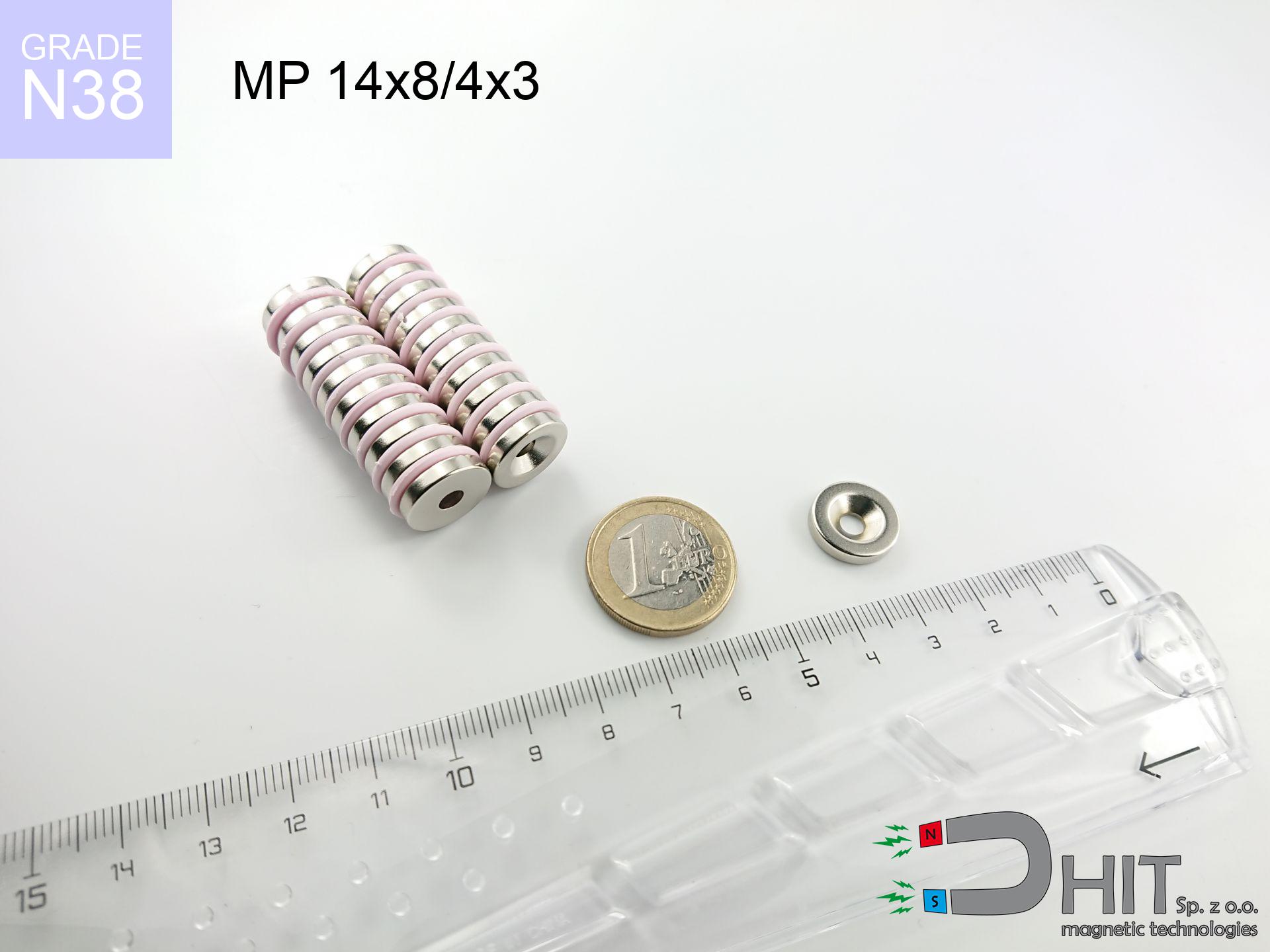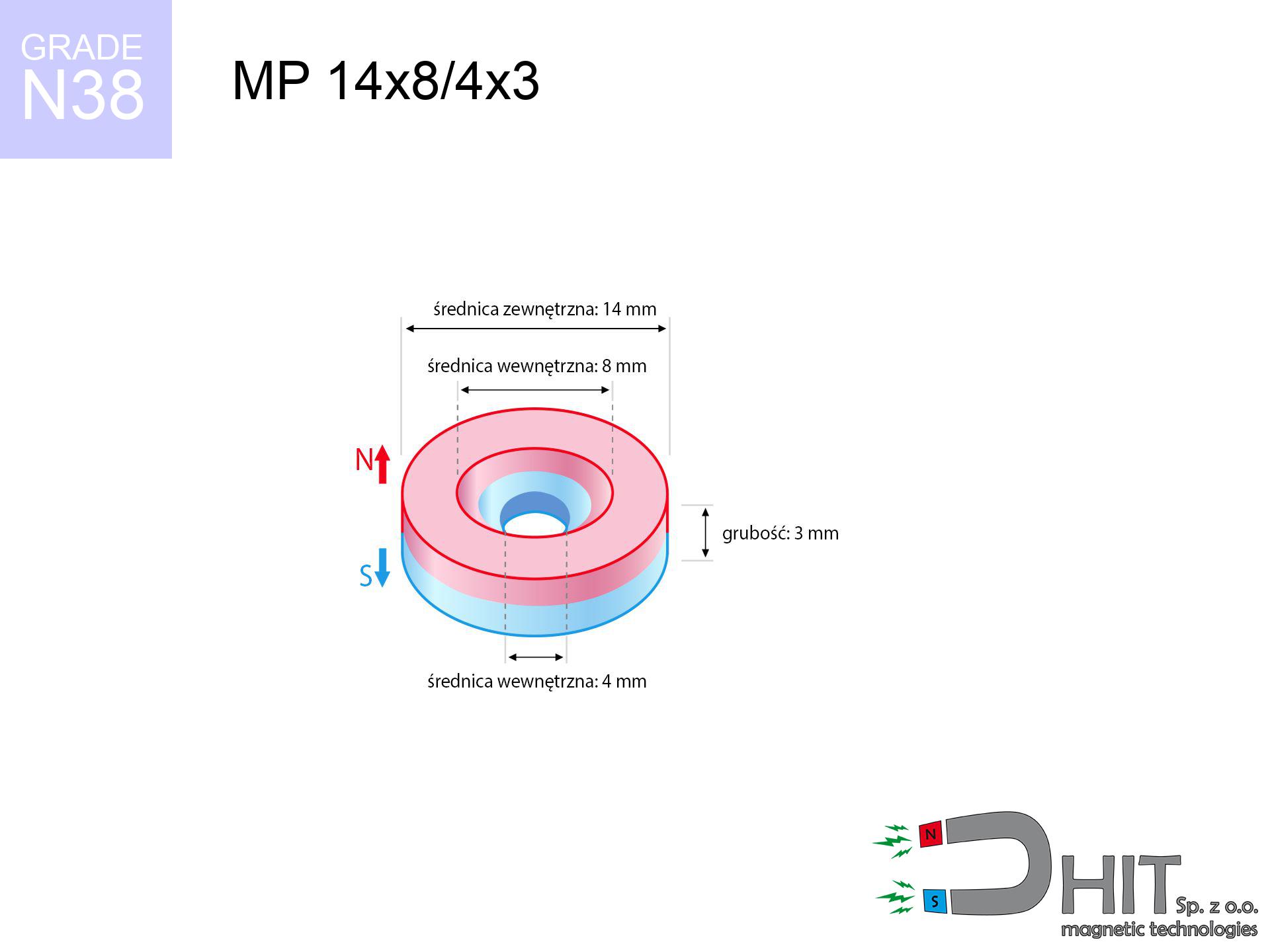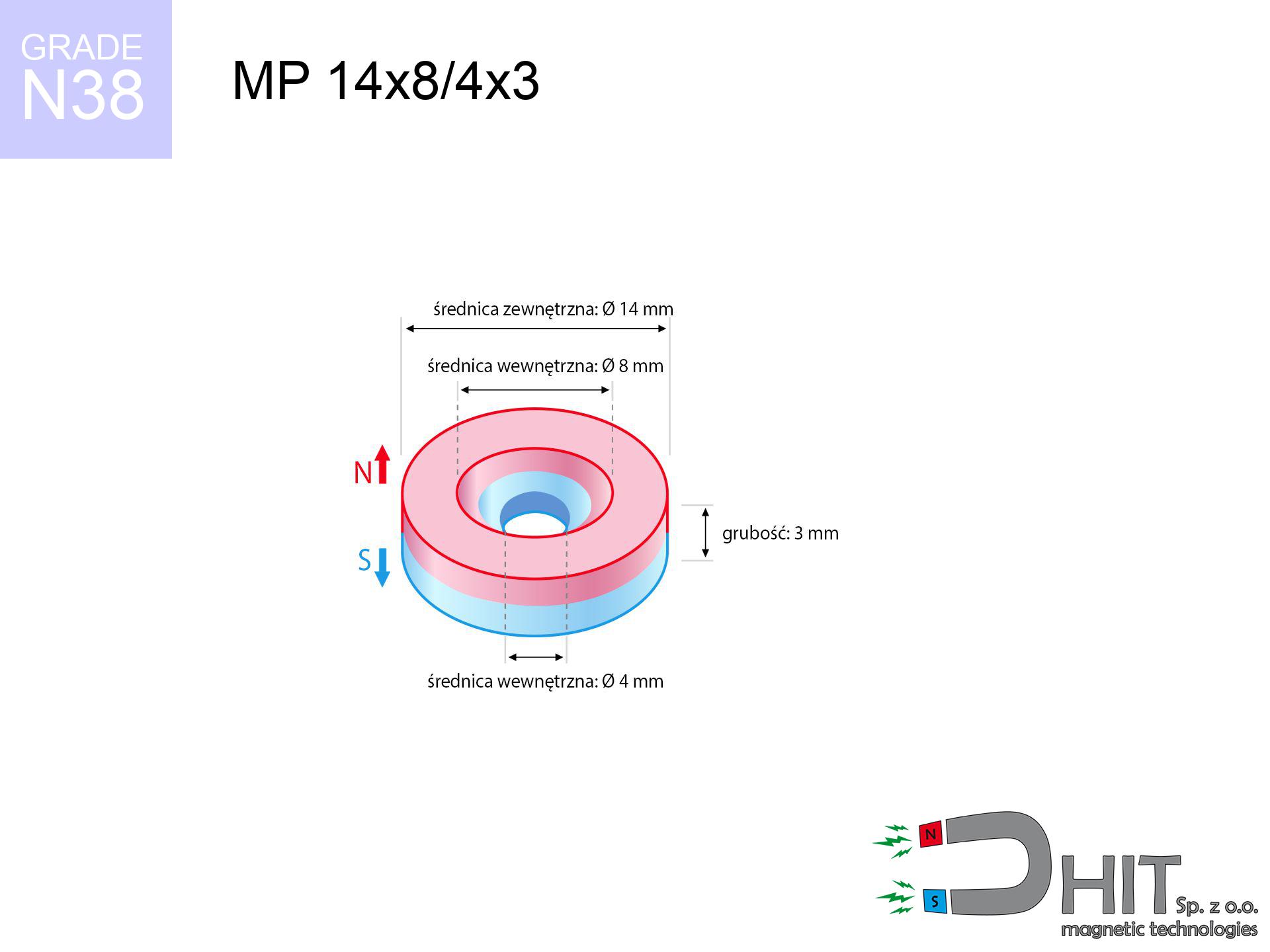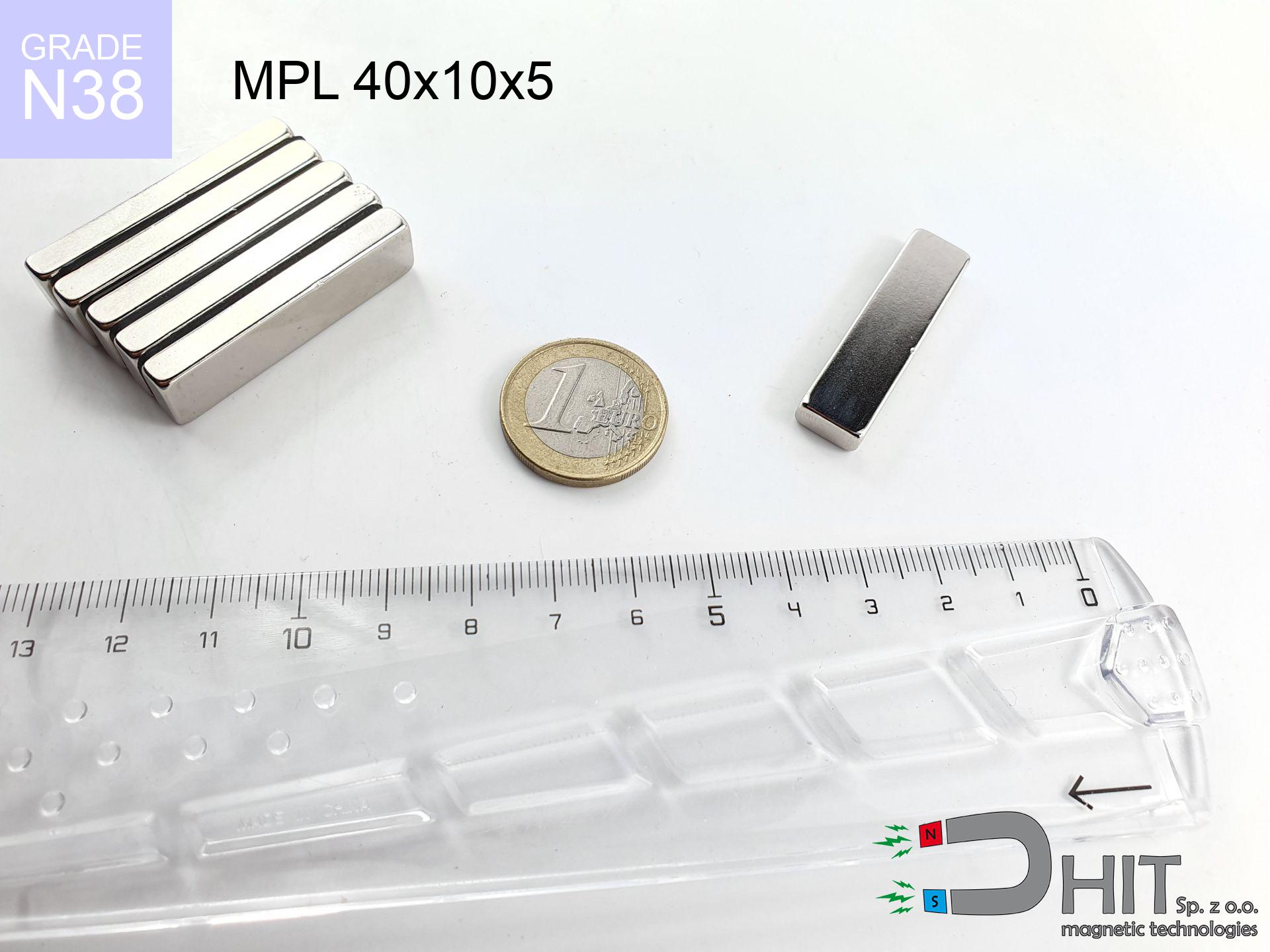MP 14x8/4x3 / N38 - ring magnet
ring magnet
Catalog no 030181
GTIN: 5906301811985
Diameter
14 mm [±0,1 mm]
internal diameter Ø
8/4 mm [±0,1 mm]
Height
3 mm [±0,1 mm]
Weight
5.65 g
Magnetization Direction
↑ axial
Load capacity
1.03 kg / 10.1 N
Magnetic Induction
270.17 mT
Coating
[NiCuNi] nickel
2.47 ZŁ with VAT / pcs + price for transport
2.01 ZŁ net + 23% VAT / pcs
bulk discounts:
Need more?Not sure about your choice?
Pick up the phone and ask
+48 22 499 98 98
or get in touch through
our online form
through our site.
Weight as well as shape of a neodymium magnet can be reviewed using our
power calculator.
Orders placed before 14:00 will be shipped the same business day.
Magnetic properties of material N38
Physical properties of sintered neodymium magnets Nd2Fe14B at 20°C
Shopping tips
Strengths and weaknesses of rare earth magnets.
Apart from their strong magnetism, neodymium magnets have these key benefits:
- They have constant strength, and over nearly ten years their attraction force decreases symbolically – ~1% (in testing),
- They maintain their magnetic properties even under strong external field,
- In other words, due to the reflective layer of gold, the element looks attractive,
- Magnetic induction on the working layer of the magnet is maximum,
- Thanks to resistance to high temperature, they are capable of working (depending on the shape) even at temperatures up to 230°C and higher...
- Thanks to freedom in designing and the ability to customize to individual projects,
- Significant place in modern industrial fields – they are utilized in hard drives, motor assemblies, diagnostic systems, also other advanced devices.
- Thanks to their power density, small magnets offer high operating force, occupying minimum space,
Problematic aspects of neodymium magnets: tips and applications.
- To avoid cracks upon strong impacts, we suggest using special steel housings. Such a solution secures the magnet and simultaneously increases its durability.
- Neodymium magnets lose strength when exposed to high temperatures. After reaching 80°C, many of them experience permanent drop of power (a factor is the shape and dimensions of the magnet). We offer magnets specially adapted to work at temperatures up to 230°C marked [AH], which are extremely resistant to heat
- When exposed to humidity, magnets start to rust. To use them in conditions outside, it is recommended to use protective magnets, such as magnets in rubber or plastics, which secure oxidation as well as corrosion.
- Due to limitations in producing threads and complex shapes in magnets, we propose using casing - magnetic holder.
- Health risk to health – tiny shards of magnets can be dangerous, if swallowed, which gains importance in the context of child safety. Additionally, small elements of these devices can disrupt the diagnostic process medical in case of swallowing.
- High unit price – neodymium magnets are more expensive than other types of magnets (e.g. ferrite), which increases costs of application in large quantities
Maximum magnetic pulling force – what affects it?
The lifting capacity listed is a measurement result performed under standard conditions:
- using a plate made of high-permeability steel, acting as a ideal flux conductor
- possessing a thickness of min. 10 mm to ensure full flux closure
- with a plane cleaned and smooth
- with direct contact (no impurities)
- under perpendicular force direction (90-degree angle)
- at room temperature
Key elements affecting lifting force
Bear in mind that the magnet holding will differ subject to elements below, starting with the most relevant:
- Clearance – the presence of foreign body (paint, dirt, air) acts as an insulator, which reduces power steeply (even by 50% at 0.5 mm).
- Force direction – remember that the magnet has greatest strength perpendicularly. Under sliding down, the capacity drops drastically, often to levels of 20-30% of the maximum value.
- Metal thickness – the thinner the sheet, the weaker the hold. Part of the magnetic field passes through the material instead of converting into lifting capacity.
- Material type – the best choice is high-permeability steel. Hardened steels may generate lower lifting capacity.
- Base smoothness – the more even the surface, the better the adhesion and higher the lifting capacity. Roughness creates an air distance.
- Temperature – temperature increase causes a temporary drop of induction. Check the maximum operating temperature for a given model.
* Holding force was checked on the plate surface of 20 mm thickness, when the force acted perpendicularly, in contrast under shearing force the holding force is lower. Moreover, even a slight gap {between} the magnet and the plate decreases the lifting capacity.
Precautions when working with NdFeB magnets
Medical implants
Life threat: Neodymium magnets can turn off heart devices and defibrillators. Stay away if you have electronic implants.
Caution required
Use magnets with awareness. Their immense force can shock even experienced users. Plan your moves and do not underestimate their power.
Cards and drives
Do not bring magnets near a wallet, computer, or TV. The magnetic field can destroy these devices and erase data from cards.
Precision electronics
Be aware: neodymium magnets produce a field that disrupts sensitive sensors. Maintain a separation from your phone, tablet, and GPS.
Pinching danger
Danger of trauma: The attraction force is so great that it can result in blood blisters, crushing, and even bone fractures. Use thick gloves.
Product not for children
These products are not suitable for play. Eating a few magnets can lead to them attracting across intestines, which poses a severe health hazard and requires urgent medical intervention.
Material brittleness
Protect your eyes. Magnets can explode upon violent connection, ejecting shards into the air. We recommend safety glasses.
Sensitization to coating
Medical facts indicate that the nickel plating (standard magnet coating) is a strong allergen. If your skin reacts to metals, avoid touching magnets with bare hands or select versions in plastic housing.
Machining danger
Drilling and cutting of neodymium magnets poses a fire hazard. Magnetic powder reacts violently with oxygen and is difficult to extinguish.
Do not overheat magnets
Standard neodymium magnets (N-type) undergo demagnetization when the temperature exceeds 80°C. This process is irreversible.
Safety First!
More info about risks in the article: Magnet Safety Guide.





![SM 25x350 [2xM8] / N42 - magnetic separator SM 25x350 [2xM8] / N42 - magnetic separator](https://cdn3.dhit.pl/graphics/products/sm-25x350-2xm8-pim.jpg)




